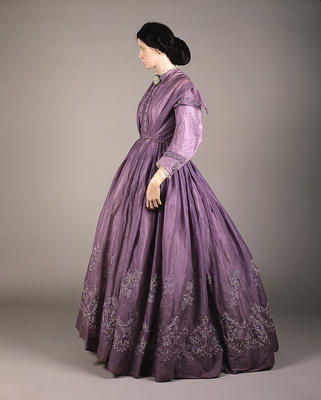
A lilac-coloured tamboured muslin day dress from the 1860s, probably made in Glasgow.
The west of Scotland was renowned for tamboured muslins, which were produced by women and girls working from home. The cloth was stretched over a hoop (or tambour) and held in place by an outer hoop. The tambourer then held the hoop between her knee and her chin (or supported it on a pedestal) and embroidered sprays of flowers onto the cloth using cotton thread. The embroidery was done with a small hook rather than a needle and this gave an appearance of chain-work.
The Statistical Account for 1793 mentions tambouring as one of the skills taught to destitute women in the Town's Hospital and Poorhouse in Glasgow. During the early 19th century up to 20,000 women and girls are believed to have worked as tambourers in Britain and the Board for Fisheries and Manufacture introduced classes in design to improve the standards of workmanship.
Reference: E.1988.110.1
Reproduced with the permission of Glasgow City Council, Glasgow Museums
Keywords:
Board for Fisheries and Manufacture, day dresses, dressmakers, dressmaking, fashions, mannequins, tambourers, tambouring, Town's Hospital and Poorhouse, women
You have 1 image in your photo album.